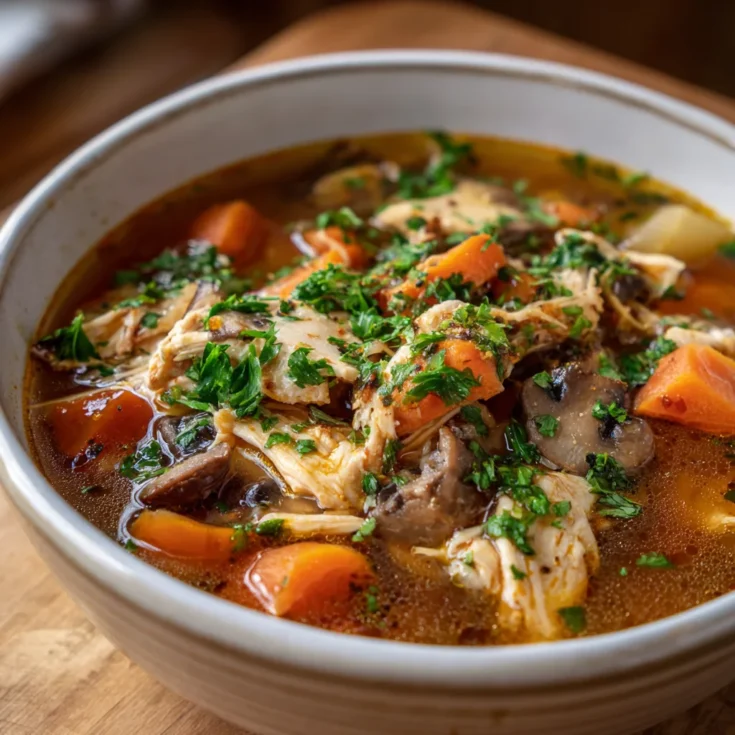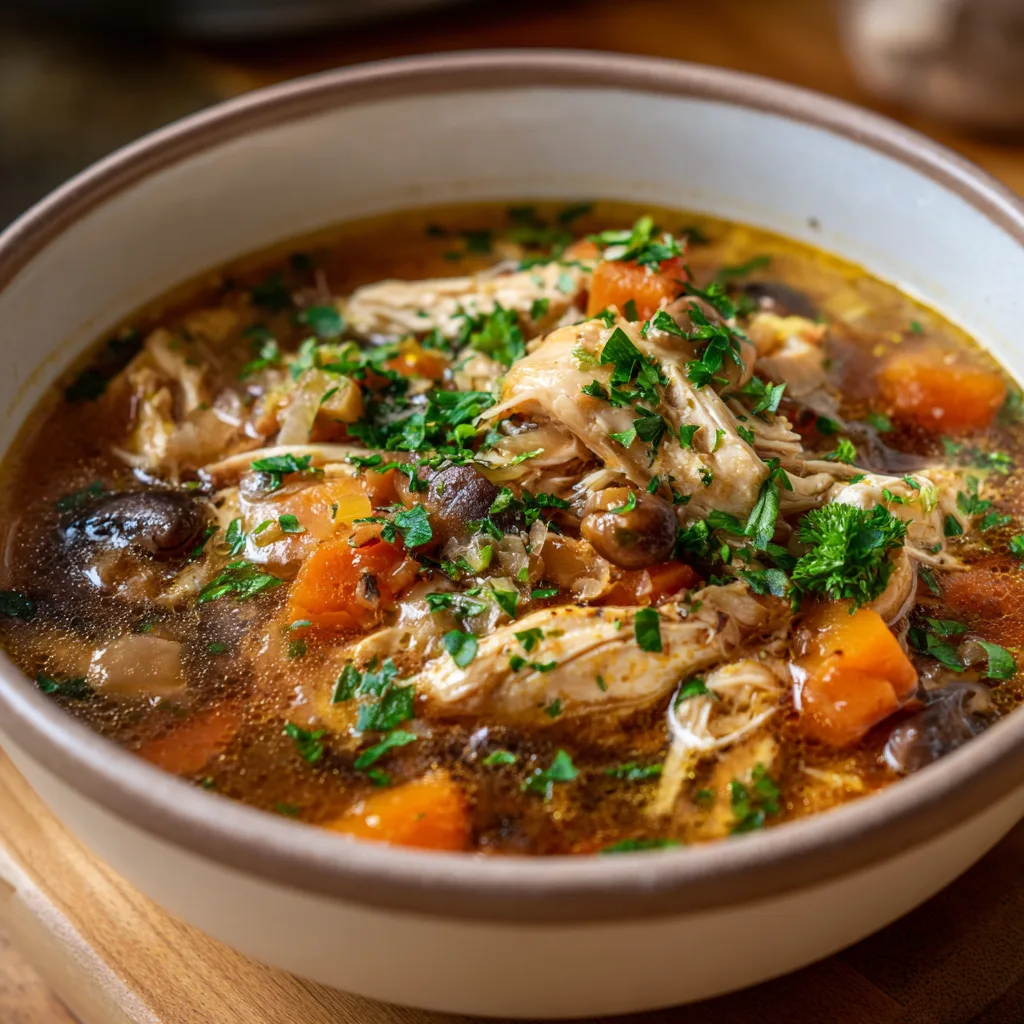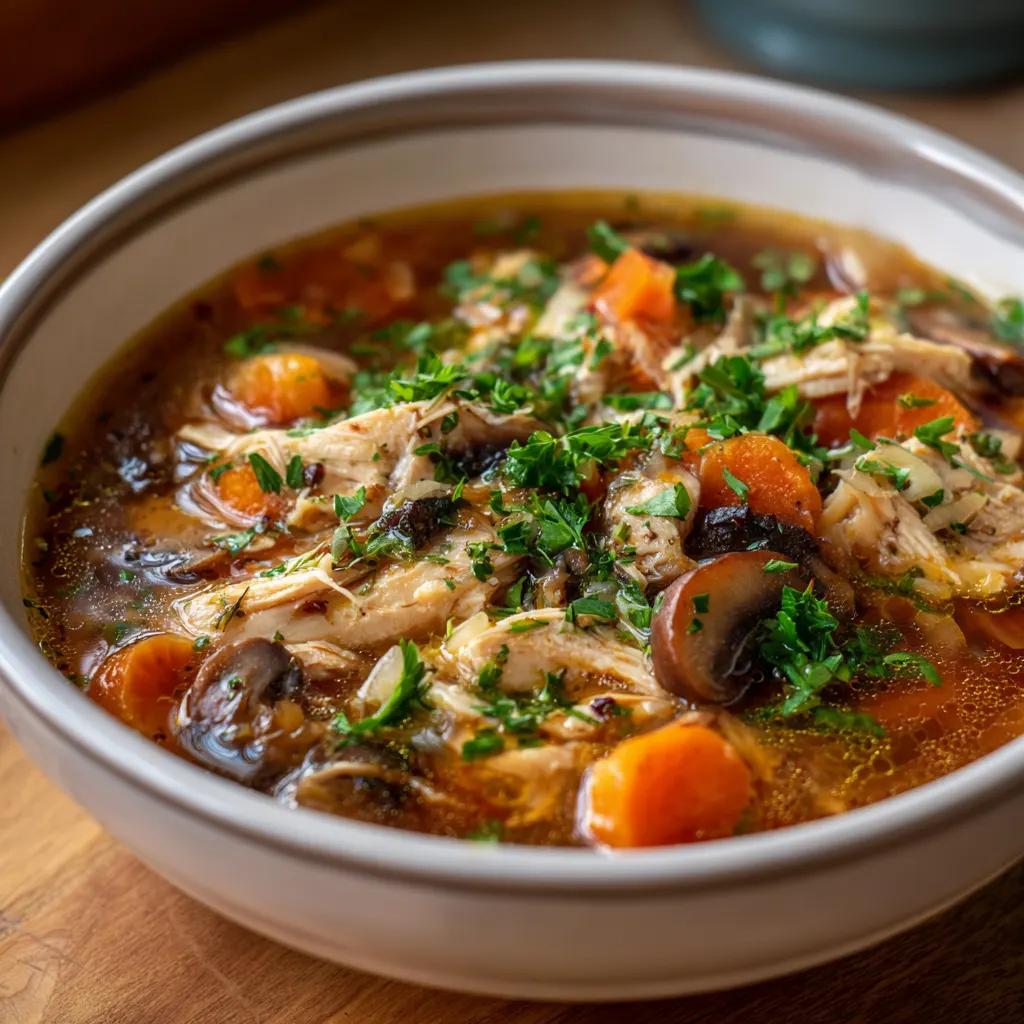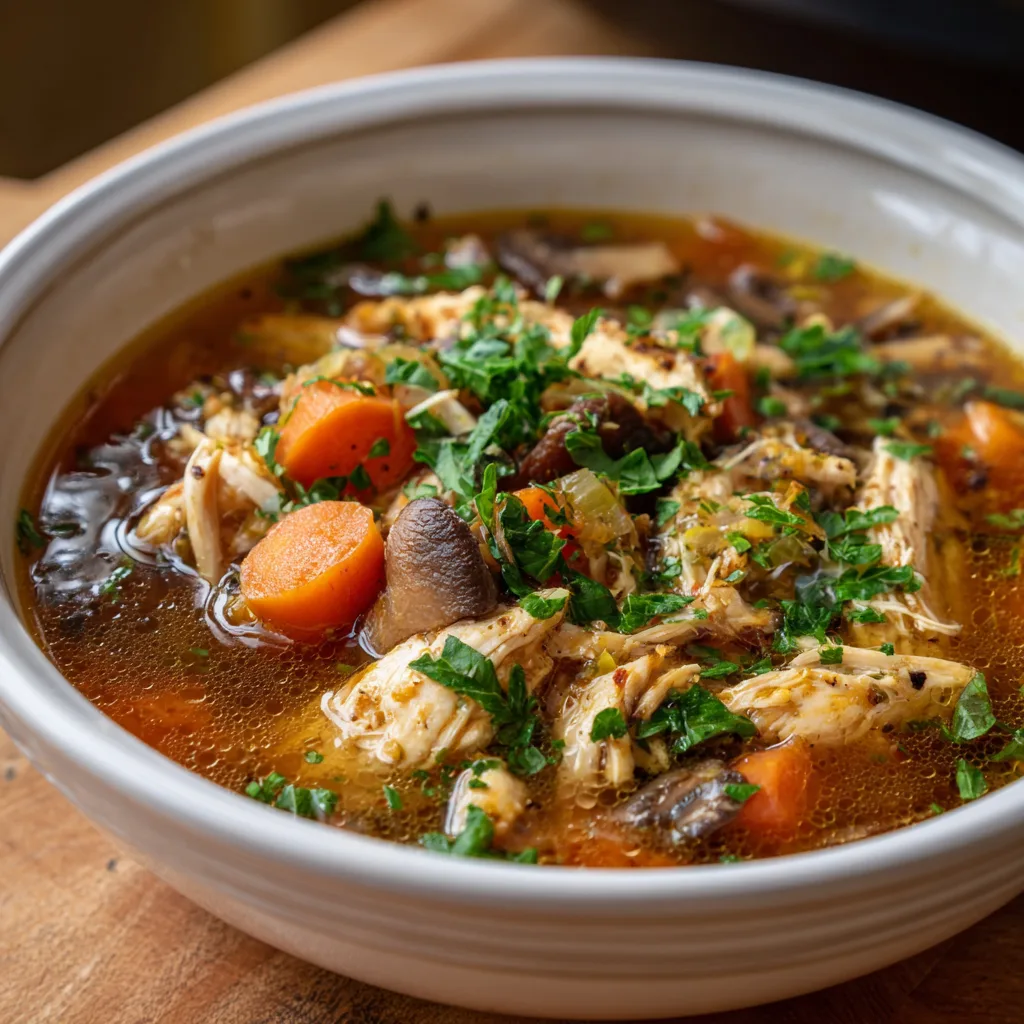Introduction to Family-Friendly Slow Cooked Chicken Breast Soup
The Appeal of Slow Cooking for Families
Slow cooking offers an effortless way to prepare wholesome meals, especially for busy families. By simply adding ingredients to the slow cooker, you free up valuable time during hectic days. This hands-off method lets flavors develop deeply while you focus on other tasks. Plus, slow cooking enhances tenderness and melds tastes perfectly. For families juggling work, school, and activities, slow cooker recipes provide a reliable solution to serve nutritious dinners without the stress of constant monitoring.
Why Chicken Breast is a Preferred Choice
Chicken breast stands out as a top pick for family meals. It’s packed with lean protein, making it ideal for maintaining a healthy diet. This cut is low in fat but rich in essential nutrients like vitamins B6 and niacin. Its mild flavor blends well with a wide range of seasonings and vegetables. Additionally, chicken breast cooks quickly and absorbs flavors effectively, ensuring every spoonful of soup tastes satisfying and nourishing. These qualities make it perfect for slow-cooked soups tailored to all ages.
Overview of the Article
This article guides you through crafting a delicious, family-friendly slow cooked chicken breast soup. You’ll discover key ingredients, preparation tips, and step-by-step cooking instructions. We also cover ways to customize the soup to suit dietary needs and flavor preferences. Lastly, a detailed recipe card will help you recreate this comforting dish effortlessly. Whether you’re a seasoned cook or just starting out, this comprehensive guide will make meal planning easier and more enjoyable
Essential Ingredients for a Nutritious Soup
Lean Protein Sources: Choosing Boneless, Skinless Chicken Breast
Boneless, skinless chicken breast remains a favorite lean protein for soups. It provides a clean, mild flavor that adapts well to many seasonings and ingredients. This cut is low in fat and high in protein, making it ideal for families aiming for healthier meals. Without the skin, the soup avoids excess grease, resulting in a lighter, more digestible dish. Additionally, chicken breast cooks evenly and quickly in the slow cooker, ensuring tender, juicy meat that blends perfectly with other soup components.
Vegetables for Flavor and Nutrition: Carrots, Celery, Onions, and Garlic
Vegetables serve as the backbone of any nourishing soup. Carrots bring natural sweetness and vibrant color, while celery adds a subtle crunch and fresh aroma. Onions provide depth and richness, and garlic infuses a robust, savory punch. Together, these ingredients create a balanced flavor base. They also pack essential vitamins, minerals, and fiber to support overall health. Chopping these vegetables uniformly allows them to cook evenly, releasing their full flavor potential into the broth during slow cooking.
Flavor Enhancers: Herbs and Spices Like Thyme, Rosemary, and Bay Leaves
Herbs and spices elevate the soup by layering complex tastes without adding calories. Thyme offers a gentle earthiness that complements chicken beautifully. Rosemary delivers a pine-like fragrance, adding warmth to the dish. Bay leaves contribute subtle floral notes and depth during the long simmer. Using dried or fresh herbs both work well in slow cooking, as the extended heat releases their essential oils gradually. Seasoning with salt and pepper balances these flavors, rounding out the soup’s profile perfectly.
Broth Selection: Homemade vs. Store-Bought Chicken Broth Options
Choosing the right broth impacts the soup’s richness and healthfulness. Homemade chicken broth typically contains fewer additives and excess sodium. It offers a fuller, more natural flavor developed by simmering bones and vegetables over hours. On the other hand, store-bought broth provides convenience and consistency, making it a practical choice for busy households. Opting for low-sodium varieties lets you control salt levels while maintaining taste. Either option works well, especially when combined with fresh ingredients and herbs.
Optional Add-Ins: Noodles, Rice, or Beans for Variety
To tailor the soup to different preferences, consider optional add-ins. Noodles bring comfort and substance, appealing to kids and adults alike. Rice provides a gluten-free alternative that absorbs flavors and softens beautifully. Beans contribute protein and fiber, boosting the soup’s nutritional value and making it more filling. Adding these ingredients near the end of cooking prevents over-softening and keeps textures pleasant. Incorporating them offers flexibility, letting families customize the soup to their tastes and dietary needs.
Preparation Tips
Prepping the Chicken: Trimming and Cutting Techniques
Start by trimming excess fat or connective tissue from the chicken breasts. This step ensures a cleaner taste and avoids chewy bits in the soup. Next, cut the breasts into even-sized pieces or leave them whole if you prefer shredding after cooking. Smaller pieces cook faster and blend well with vegetables, while whole breasts retain moisture and can be shredded for texture. Properly prepped chicken cooks uniformly, enhancing the soup’s overall consistency.
Chopping Vegetables: Uniform Cuts for Even Cooking
Aim to chop carrots, celery, and onions into similar-sized pieces. This consistency allows the vegetables to soften evenly during the long cook time. Roughly one-half inch cubes work well to maintain some texture without being too firm. Mince garlic finely to disperse its flavor throughout the soup. Using uniform cuts improves presentation and ensures a balanced taste in every spoonful. It also prevents some veggies from becoming mushy while others remain undercooked.
Layering in the Slow Cooker: Enhancing Flavor Extraction
Layering ingredients strategically in the slow cooker affects how flavors develop. Place denser vegetables like carrots and celery at the bottom, as they take longer to soften. Add chicken breast next to ensure even heat exposure and proper cooking. Top with onions, garlic, and herbs to allow their aromas to infuse the broth gradually. Pour the broth over all ingredients, ensuring they remain submerged for even simmering. Proper layering creates a harmonious blend of flavors and textures throughout the soup.
Step-by-Step Cooking Instructions for Family-Friendly Slow Cooked Chicken Breast Soup
Setting Up the Slow Cooker: Choosing the Right Temperature and Timing
Begin by setting your slow cooker to the low setting for best results. Cooking chicken breast slowly on low heat—typically between 6 to 8 hours—ensures tender, juicy meat and allows flavors to meld fully. While the high setting cooks faster, usually within 3 to 4 hours, it risks drying out the chicken. For busy families, the low setting fits well with a day’s schedule, offering convenience and delicious results. Always ensure the slow cooker lid fits tightly to retain heat and moisture during cooking.
Monitoring the Soup: Checking Doneness and Balancing Flavors
Although slow cooking requires minimal intervention, checking your soup near the end of cooking is essential. Test the chicken’s internal temperature; it should reach 165°F (75°C) to ensure safety. Evaluate the vegetables for tenderness—they should be soft but not mushy. Taste the broth and adjust seasoning if necessary, adding salt or pepper in small increments. If the soup tastes bland, a splash of lemon juice or a pinch of herbs can brighten the flavors. Avoid opening the lid frequently during cooking to prevent heat loss.
Shredding the Chicken: Easy Techniques After Cooking
Once the chicken is fully cooked, remove it carefully from the slow cooker using tongs or a slotted spoon. Place the chicken on a cutting board or plate. Use two forks to shred the meat by pulling it apart into bite-sized pieces. Alternatively, you can use a stand mixer with a paddle attachment on low speed for faster shredding. Return the shredded chicken to the slow cooker, stirring it gently into the soup to soak up the broth’s rich flavors. Shredding creates a satisfying texture that blends seamlessly with the vegetables.
Final Adjustments: Enhancing Flavor and Perfecting Consistency
After mixing the shredded chicken back in, let the soup cook for an additional 10 to 15 minutes to meld flavors. At this stage, you can add optional ingredients like noodles, rice, or beans if desired, allowing them to cook until tender. Check the soup’s consistency—if it seems too thick, stir in a little extra broth or water. For thinner soup, simmer uncovered for a few minutes to reduce excess liquid. Taste one last time and adjust seasoning accordingly. Adding fresh herbs or a squeeze of lemon juice at the end can elevate the soup’s aroma and brightness, making it ready to serve.
Serving Your Family-Friendly Slow Cooked Chicken Breast Soup
Presentation Ideas: Garnishes and Visual Appeal
Enhance your soup’s appeal by adding fresh garnishes just before serving. Sprinkle chopped fresh parsley or cilantro for a pop of color and freshness. Thinly sliced green onions or chives add a mild onion flavor and visual interest. A few lemon wedges on the side allow diners to brighten the soup with a splash of citrus. For a creamy touch, consider a dollop of plain Greek yogurt or a swirl of coconut milk. These simple touches elevate the dish, making it more inviting for the whole family.
Pairing with Side Dishes: Complementary Flavors and Textures
Pair your chicken breast soup with sides that add texture and balance. A warm, crusty bread or whole-grain roll is perfect for dipping and soaking up the broth. Fresh salads with crisp greens and light vinaigrette provide a refreshing contrast. Steamed or roasted vegetables like broccoli, green beans, or asparagus bring added nutrients and color to the meal. These sides help round out the dinner, turning a simple soup into a satisfying, complete family feast.
Recipe Variations to Suit Different Preferences
Low-Carb Options: Using Zucchini Noodles or Cauliflower Rice
For those following a low-carb lifestyle, swap traditional noodles or rice for zucchini noodles or cauliflower rice. These alternatives reduce carbohydrates while maintaining volume and texture. Add zucchini noodles in the last 15 minutes of cooking to keep them tender but firm. Cauliflower rice works well stirred in near the end, soaking up flavors without overpowering the soup. These swaps keep the meal light and nutritious without sacrificing satisfaction.
Gluten-Free Adaptations: Ensuring a Safe and Delicious Meal
To make this soup gluten-free, verify that all broth and seasoning ingredients do not contain gluten or hidden additives. Choose certified gluten-free noodles or omit noodles entirely, relying on vegetables and protein for substance. Many beans and rice options naturally avoid gluten and add heartiness. This adaptation makes the soup accessible for those with gluten sensitivities or celiac disease while preserving its comforting qualities.
Vegetarian Alternatives: Plant-Based Protein Substitutes
For a vegetarian take, replace chicken breast with plant-based proteins like firm tofu, tempeh, or chickpeas. Tofu and tempeh absorb flavors well and provide protein, while chickpeas add texture and fiber. Use vegetable broth instead of chicken broth to maintain a fully vegetarian profile. Adjust cooking times to ensure the substitutes cook properly without becoming mushy. This variation creates a nourishing, flavorful soup that meets diverse dietary needs without compromising taste.
FAQs About Slow Cooked Chicken Breast Soup
Can I Use Frozen Chicken Breast?
Yes, you can use frozen chicken breast in your slow cooker soup, but it requires careful handling. Always ensure the chicken reaches a safe internal temperature of 165°F (75°C) to prevent foodborne illness. Cooking frozen chicken may extend the cooking time by about 30 minutes to an hour. For best results, thaw chicken overnight in the refrigerator before adding it to the slow cooker. This helps the meat cook evenly and reduces the risk of uneven cooking or bacterial growth.
How Long Can I Store Leftovers?
Store leftover soup promptly in airtight containers to maintain freshness and safety. Refrigerated leftovers last about 3 to 4 days. For longer storage, freeze the soup in portioned containers, where it can remain good for up to 3 months. When reheating, thaw frozen soup overnight in the fridge, then heat thoroughly until steaming hot throughout. Avoid repeated reheating, as this can affect both safety and flavor. Label containers with the date to keep track of storage times.
Can I Add Dairy to the Soup?
Adding dairy such as cream, milk, or yogurt can enrich the soup, creating a creamy texture and mellow flavor. For best results, stir in dairy during the last 15 to 20 minutes of cooking or after removing the soup from heat to prevent curdling. Consider using alternatives like coconut milk or almond milk for a dairy-free creamy option. Always taste and adjust seasoning after adding dairy, as it can soften the soup’s overall flavor.
How Do I Make the Soup Spicier?
To add heat, introduce spices like cayenne pepper, crushed red pepper flakes, or smoked paprika. Start with small amounts—about ¼ to ½ teaspoon—and adjust to taste. Fresh ingredients like diced jalapeño or serrano peppers can also bring a lively kick. Adding hot sauce near the end of cooking lets you control spice levels precisely. Remember to balance spice with other flavors, ensuring the soup remains family-friendly and enjoyable for everyone.
Family-Friendly Slow Cooked Chicken Breast Soup – Cozy & Healthy Dinner

This hearty and nutritious soup features tender slow-cooked chicken breast paired with fresh vegetables and aromatic herbs. It’s an ideal meal for family dinners that comforts and nourishes.
Ingredients
- 1.5 lbs boneless, skinless chicken breast
- 4 cups low-sodium chicken broth
- 2 carrots, diced
- 2 celery stalks, diced
- 1 onion, chopped
- 3 cloves garlic, minced
- 1 tsp dried thyme
- 1 tsp dried rosemary
- 2 bay leaves
- Salt and pepper to taste
- Optional: 1 cup gluten-free noodles or zucchini noodles
Instructions
- Place chicken breast at the bottom of the slow cooker.
- Add diced carrots, celery, onion, and minced garlic on top.
- Pour in chicken broth and sprinkle herbs, salt, and pepper.
- Stir gently to combine all ingredients.
- Cover and cook on low for 6 hours.
- Remove chicken breast carefully, shred using two forks, and return shredded meat to the slow cooker.
- If using noodles, stir them in and cook for an additional 30 minutes on low.
- Taste and adjust seasoning before serving.
Notes
- For a creamier texture, add ½ cup coconut milk or almond milk during the last 30 minutes of cooking.
- To increase spice, mix in ½ teaspoon cayenne pepper or a diced jalapeño pepper.
- For a low-carb version, omit noodles and add extra vegetables like spinach or kale.




